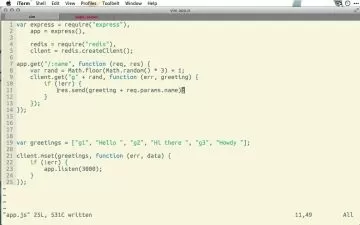Redis: The Complete Developer's Guide
Stephen Grider
15:38:28
Description
Master Redis v7.0 with hands-on exercises. Includes Modules, Scripting, Concurrency, and Streams!
What You'll Learn?
- Use Redis as an incredibly fast database for a backend application
- Extend the functionality of Redis by using custom scripts and modules
- Add, update, and query your data using simple and flexible commands
- Get hands-on experience by adding Redis to a complex E-Commerce project
- Handle concurrency issues by using powerful synchronization primitives
- Utilize data streams to add durable communication between servers
- Host your Redis database in AWS, GCP, or Azure using Redis Cloud
- Analyze and balance the tradeoffs of Redis's different data structures
Who is this for?
What You Need to Know?
More details
DescriptionIn a world with hundreds of different databases, one database rises to rule them all.Â
Redis is an in-memory database known for its speed and simplicity. Originally used only for simple caching, its feature set has expanded to be one of the most versatile databases around.Â
This course will teach you everything you need to know to integrate Redis into a new or existing project.
Get hands-on experience with commands used to add, update, and query data
Apply best practices and numerous design patterns by adding Redis to an E-Commerce app
Understand and extend the internals of Redis by using modules and scripts
Go beyond Redis with a deep look at fundamental concurrency issues and solutions
Data structures form the heart of Redis. Rather than hiding functionality behind complex abstractions, Redis exposes several powerful data structures that developers use to store and query data. Learning about these different data structures is the key to mastering Redis. This course focuses on making sure that you understand the difference between a sorted set and a hash.  After completing this course, you'll understand when to use each structure and the benefits and drawbacks to each. Don't have a background in algorithms or data structures? That's OK! Everything in this course assumes you have no prior knowledge.
Almost all top companies around the world use Redis. Twitter, GitHub, Snapchat, Craigslist, StackOverflow - they all use Redis! Nearly every major web product you use on a daily basis utilizes Redis behind the scenes. And its not just large companies that use Redis - small startups do as well.Â
To understand Redis, you must use Redis. Just memorizing commands isn't enough. You need to get your hands dirty! With that in mind, you'll work through many exercises and quizzes. In addition, throughout this entire course you will build a large E-Commerce application using Redis. Don't worry - you won't need to write any frontend code. As we learn new topics in Redis, we will add new features to our E-Commerce app. You'll get to see why and when we use each major feature of Redis.
Built-in cheatsheets. Many resources about Redis show running commands in a terminal window. This approach makes it hard to remember even the most basic commands. In this course, you'll take a different approach. I built a standalone webapp called RBook just for you to use in this course. This app allows you to run commands against your own Redis instance and document them at the same time, making it easy for you to refer back to your notes in the future. Of course, you don't have to use RBook if you don't want to!
Effective learning. Everything in this course is designed to make your learning process as easy as possible.
At every step, I will teach you what Redis is doing internally, and help you understand how to twist and bend Redis to better suit your application's needs.
Every single video in the course has an attached ZIP file containing up-to-date code, just in case you ever get stuck.
Full-time teaching assistants are standing by to help answer your questions.
Access to a private live chat server is included. Live help whenever you need it!
Soooo much more. Here's a partial of some of the things you will do in this course:
Write basic commands to store, update, and query data
Practice your skills with exercises and quizzes
Use almost every major feature of Redis to build an E-Commerce app
Enforce data constraints using sets, sorted sets, and lists
Understand when to use each of Redis's major data structures
Apply numerous design patterns to integrate Redis into an existing codebase
Securely deploy a Redis instance using AWS, GCP, or Azure through Redis Cloud
Collect stats and metrics sourced from a live API
Communicate between different servers using Streams
Master the concept of transactions to safely store data
Implement a standard locking algorithm to solve concurrency issues
Redis is known for being simple, but it is still hard to learn. You're given a huge toolbox with tons of features, but no clear guidance on when to use each feature. This course aims to give you direction. You'll understand why each feature exists, and when to use them in real apps. You will find learning Redis a delightful experience and pick up a tremendous amount of knowledge along the way.
Sign up today and join me in mastering Redis!
Who this course is for:
- Developers looking to speed up their existing web app
- Engineers who want to use an extremely fast database
In a world with hundreds of different databases, one database rises to rule them all.Â
Redis is an in-memory database known for its speed and simplicity. Originally used only for simple caching, its feature set has expanded to be one of the most versatile databases around.Â
This course will teach you everything you need to know to integrate Redis into a new or existing project.
Get hands-on experience with commands used to add, update, and query data
Apply best practices and numerous design patterns by adding Redis to an E-Commerce app
Understand and extend the internals of Redis by using modules and scripts
Go beyond Redis with a deep look at fundamental concurrency issues and solutions
Data structures form the heart of Redis. Rather than hiding functionality behind complex abstractions, Redis exposes several powerful data structures that developers use to store and query data. Learning about these different data structures is the key to mastering Redis. This course focuses on making sure that you understand the difference between a sorted set and a hash.  After completing this course, you'll understand when to use each structure and the benefits and drawbacks to each. Don't have a background in algorithms or data structures? That's OK! Everything in this course assumes you have no prior knowledge.
Almost all top companies around the world use Redis. Twitter, GitHub, Snapchat, Craigslist, StackOverflow - they all use Redis! Nearly every major web product you use on a daily basis utilizes Redis behind the scenes. And its not just large companies that use Redis - small startups do as well.Â
To understand Redis, you must use Redis. Just memorizing commands isn't enough. You need to get your hands dirty! With that in mind, you'll work through many exercises and quizzes. In addition, throughout this entire course you will build a large E-Commerce application using Redis. Don't worry - you won't need to write any frontend code. As we learn new topics in Redis, we will add new features to our E-Commerce app. You'll get to see why and when we use each major feature of Redis.
Built-in cheatsheets. Many resources about Redis show running commands in a terminal window. This approach makes it hard to remember even the most basic commands. In this course, you'll take a different approach. I built a standalone webapp called RBook just for you to use in this course. This app allows you to run commands against your own Redis instance and document them at the same time, making it easy for you to refer back to your notes in the future. Of course, you don't have to use RBook if you don't want to!
Effective learning. Everything in this course is designed to make your learning process as easy as possible.
At every step, I will teach you what Redis is doing internally, and help you understand how to twist and bend Redis to better suit your application's needs.
Every single video in the course has an attached ZIP file containing up-to-date code, just in case you ever get stuck.
Full-time teaching assistants are standing by to help answer your questions.
Access to a private live chat server is included. Live help whenever you need it!
Soooo much more. Here's a partial of some of the things you will do in this course:
Write basic commands to store, update, and query data
Practice your skills with exercises and quizzes
Use almost every major feature of Redis to build an E-Commerce app
Enforce data constraints using sets, sorted sets, and lists
Understand when to use each of Redis's major data structures
Apply numerous design patterns to integrate Redis into an existing codebase
Securely deploy a Redis instance using AWS, GCP, or Azure through Redis Cloud
Collect stats and metrics sourced from a live API
Communicate between different servers using Streams
Master the concept of transactions to safely store data
Implement a standard locking algorithm to solve concurrency issues
Redis is known for being simple, but it is still hard to learn. You're given a huge toolbox with tons of features, but no clear guidance on when to use each feature. This course aims to give you direction. You'll understand why each feature exists, and when to use them in real apps. You will find learning Redis a delightful experience and pick up a tremendous amount of knowledge along the way.
Sign up today and join me in mastering Redis!
Who this course is for:
- Developers looking to speed up their existing web app
- Engineers who want to use an extremely fast database
User Reviews
Rating
Stephen Grider
Instructor's Courses
Udemy
View courses Udemy- language english
- Training sessions 176
- duration 15:38:28
- English subtitles has
- Release Date 2024/03/12














